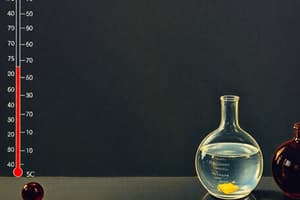Podcast
Questions and Answers
What are the seven base SI units used in chemistry?
What are the seven base SI units used in chemistry?
meter, kilogram, second, ampere, kelvin, mole, candela
What does the acronym SI stand for in the context of units?
What does the acronym SI stand for in the context of units?
International System of Units
Leading zeros are significant in a decimal number.
Leading zeros are significant in a decimal number.
False (B)
What does the prefix 'kilo' represent, and what is its numerical value?
What does the prefix 'kilo' represent, and what is its numerical value?
What is the formula for calculating the volume of a sphere?
What is the formula for calculating the volume of a sphere?
The consistency of repeated measurements is known as ______.
The consistency of repeated measurements is known as ______.
How close a measurement is to the true value is known as ______.
How close a measurement is to the true value is known as ______.
Which of these options are examples of systematic uncertainties?
Which of these options are examples of systematic uncertainties?
Which of these options are examples of random uncertainties?
Which of these options are examples of random uncertainties?
What are significant figures?
What are significant figures?
Scientific notation is used to simplify calculations for very large or very small numbers.
Scientific notation is used to simplify calculations for very large or very small numbers.
The Kelvin temperature scale starts from 0 Kelvin, which is equivalent to -273.15 °C.
The Kelvin temperature scale starts from 0 Kelvin, which is equivalent to -273.15 °C.
Flashcards
Density
Density
Mass per unit volume.
Density Formula
Density Formula
d = m/V, where d is density, m is mass, and V is volume.
Temperature Conversion (Kelvin to Celsius)
Temperature Conversion (Kelvin to Celsius)
K = °C + 273.15
Temperature Conversion (Celsius to Fahrenheit)
Temperature Conversion (Celsius to Fahrenheit)
Signup and view all the flashcards
Volume of a Sphere
Volume of a Sphere
Signup and view all the flashcards
Precision
Precision
Signup and view all the flashcards
Accuracy
Accuracy
Signup and view all the flashcards
SI Units
SI Units
Signup and view all the flashcards
SI Unit - meter
SI Unit - meter
Signup and view all the flashcards
SI Unit - kilogram
SI Unit - kilogram
Signup and view all the flashcards
SI Unit - second
SI Unit - second
Signup and view all the flashcards
SI Prefixes
SI Prefixes
Signup and view all the flashcards
Scientific Notation
Scientific Notation
Signup and view all the flashcards
Significant Figures
Significant Figures
Signup and view all the flashcards
Derived SI Units
Derived SI Units
Signup and view all the flashcards
Systematic Uncertainty
Systematic Uncertainty
Signup and view all the flashcards
Random Uncertainty
Random Uncertainty
Signup and view all the flashcards
Area
Area
Signup and view all the flashcards
Volume
Volume
Signup and view all the flashcards
Speed
Speed
Signup and view all the flashcards
Acceleration
Acceleration
Signup and view all the flashcards
Force
Force
Signup and view all the flashcards
Pressure
Pressure
Signup and view all the flashcards
Energy
Energy
Signup and view all the flashcards
Study Notes
Introduction
- This unit covers basic chemistry concepts, SI units, measurement uncertainties, scientific methods, lab equipment, and safety. Mastery ensures accurate experiments.
Formulas and Equations
- Density: d = m/V, where d is density, m is mass, and V is volume.
- Temperature Conversion: K = °C + 273.15; °C = (°F - 32)/1.8
- Volume of a Sphere: V = (4/3)πr³
Precision and Accuracy
- Precision: The consistency of repeated measurements.
- Accuracy: How close a measurement is to the true value.
- Demonstrating both precision and accuracy means measurements consistently close to the true value.
SI Units and Their Prefixes
- SI Units: There are seven base SI units used in chemistry: meter (m), kilogram (kg), second (s), ampere (A), kelvin (K), mole (mol), candela (cd).
- Prefixes: SI units use prefixes to indicate multiples or fractions (e.g., kilo = 103, milli = 10-3, nano = 10-9).
Scientific Notation
- Used for very large or very small numbers to simplify calculations.
- Example: 6.02 x 1023 (Avogadro's number) or 3.27 x 10-22
Significant Figures Rules
- Non-zero digits: Always significant.
- Zeros between significant digits: Significant.
- Leading zeros: Not significant.
- Trailing zeros in a decimal number: Significant.
Derived SI Units
- Area: Length squared (m²)
- Volume: Length cubed (m³)
- Density: Mass per unit volume (kg/m³)
- Speed: Distance traveled per unit time (m/s)
- Acceleration: Speed changed per unit time (m/s²)
- Force: Mass times acceleration (kg⋅m/s² = N)
- Pressure: Force per unit area (kg/(m⋅s²) = Pa)
- Energy: Force times distance traveled (kg⋅m²/s² = J)
Uncertainty in Measurements
- Systematic Uncertainties: Consistent deviations that can be corrected (e.g., calibration errors).
- Random Uncertainties: Unpredictable variations that can be reduced but not eliminated.
- Significant Figures: The meaningful digits in a measurement, indicating the precision of the measurement.
Summary
- SI Units: Seven base units (m, kg, s, A, K, mol, cd) and prefixes.
- Measurements: Systematic and random uncertainties and significant figures.
- Precision and Accuracy: Consistency and closeness to true values in measurements.
- Scientific Notation: Simplifies calculations for large/small numbers.
- Temperature Scale Celsius converted to Kelvin using K = °C + 273.15
Studying That Suits You
Use AI to generate personalized quizzes and flashcards to suit your learning preferences.




